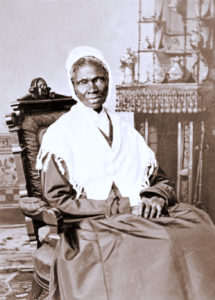So how many black women were present as the suffrage movement started in 1848 at Seneca Falls? Frederick Douglass was there. No black women attended that meeting for women’s rights.
Sojourner Truth spoke for suffrage for women as well as equal rights for all for even though the suffrage movement more and more excluded women of color as the 19th Century passed.
There is no exact transcript of Sojourner’s words from the 1851 Akron Women’s Convention. This is roughly what she (Gage version):
After the Civil war the suffragists split into two distinct groups:
- NWSA – The National Woman’s Suffrage Association was exclusive, read white, and founded after the Civil War by “traditional” women’s rights leaders, Susan B. Anthony and Elizabeth Cady Stanton who felt that women’s suffrage and racial equality were best approached separately, and that racial equality would dilute the vigor and success of the suffrage movement.
- AWSA – The American Womans Suffrage Association was inclusive -founded by Lucy Stone, Julia Ward Howe, Josephine St. Pierre Ruffin, and other s who included men and people of color.
For 20 years these groups, both still organized by whites, worked to cross purposes.
NAWSA – by 1890 these two groups merged to become the National American Woman Suffrage Association (NAWSA). At the time of their formation, the group had 7,000 members, but their ranks steadily increased to 2 million, making NAWSA the largest voluntary organization in the nation.
 Women of color had a small voice in the new and somewhat inclusive group. Black suffragist Mary Church Terrell spoke to NAWSA in 1898. The following embedded text was the speech she delivered as the closing address at the annual meeting of the Women’s Bureau of the American Missionary Association, held October 25, 1900. Church Terrell was one of the women who truly bridged the Jim Crow era and the early Civil Rights eral She was an active author and spoke out on lynching . She lived until 1954.
Women of color had a small voice in the new and somewhat inclusive group. Black suffragist Mary Church Terrell spoke to NAWSA in 1898. The following embedded text was the speech she delivered as the closing address at the annual meeting of the Women’s Bureau of the American Missionary Association, held October 25, 1900. Church Terrell was one of the women who truly bridged the Jim Crow era and the early Civil Rights eral She was an active author and spoke out on lynching . She lived until 1954.
There were active groups working for equality and the rights of people of color outside of the suffrage movement in the very early 20th Century. Mary Church Terrell was also active in the Niagara Movement from which the NAACP formed. She was a charter member of the NAACP.
St. Pierre Ruffin, Organizer, Journalist, Publisher, and Activist
Black women also worked beyond the suffrage and civil rights movement creating significant information channels that catered to their concerns and sensibilities. For example, in 1890, Josephine St. Pierre Ruffin (remember her as a cofounder of the AWSA) founded and published a monthly journal called The Woman’s Era, the nation’s first newspaper published by and for African-American women. She was a well published and credentialed journalist beyond her own publication for women of color.

St. Pierre Ruffin also was instrumental in forming the National Association of Colored Women’s Clubs (NACWC) and she was invited to the General Federation of Women’s Clubs in Milwaukee meeting in 1900 as representative of she planned to attend as a representative of three organizations – the Woman’s Era Club, the New England Woman’s Club and the New England Woman’s Press Club. The General Federation refused to seat her as a representative of the Woman’s Era Club which had an all black membership, although she would have been allowed to represent the other two clubs that were primarily composed of white members. She refused to support the Woman’s Era Club exclusion and did not attend. This is sometimes referred to as the Ruffin Incident.
In a 1915 article titled “Trust The Women!,” which St. Pierre Ruffin penned for the NAACP magazine The Crisis, St. Pierre Ruffin wrote, “Many colored men doubt the wisdom of women’s suffrage because they fear that it will increase the number of our political enemies…. [But] we are justified in believing that the success of this movement for equality of the sexes means more progress toward equality of the races.”
Ida B. Wells-Barnett and the Back of the Parade
Ida B. Wells-Barnett was another woman who carried the already established activism by black women in the 19th Century into the early 20th Century.

Wells-Barnett is well known for her work as an anti-lynching activist, and an outspoken advocate for black men’s rights, and was touched by racist violence and discrimination – which she challenged, but she also organized the Alpha Suffrage Club in Chicago in 1913 which is believed to be the first black women’s organization solely dedicated to women’s suffrage.
In the 1913 women’s procession in Washington, D.C., black women were asked to march at the back of the procession as their presence offended some white women. Wells-Barnett refused.
Wells was a fierce and vocal critic of injustice. She lived into the 1930s.
The suffrage movement had an unfortunate racist element, which we need to own up to, and cover as an all too real part of history. The suffragist fight was waged by women of all colors. Voting equality and equal access to the ballot remain problematic to this day.
Leave a Reply